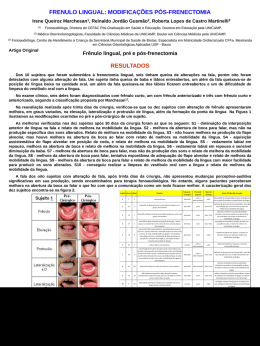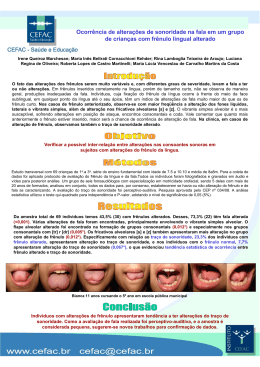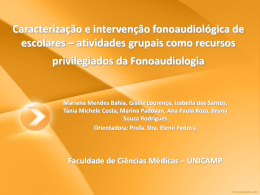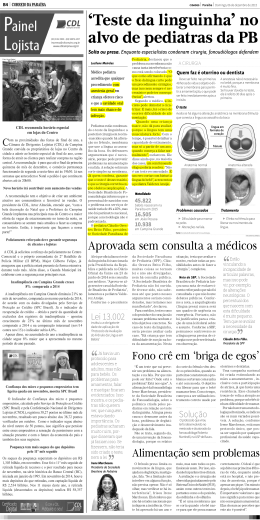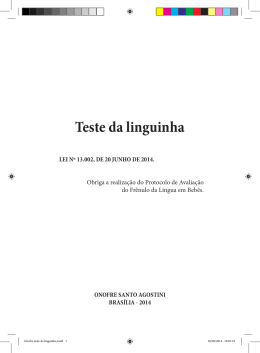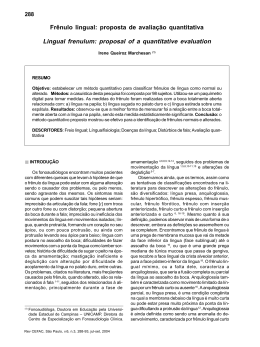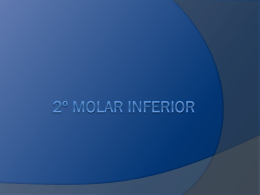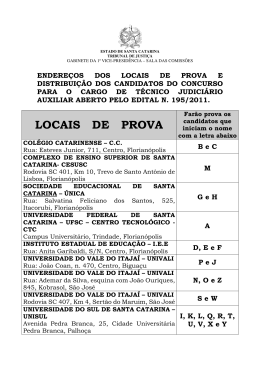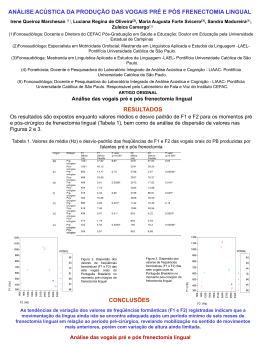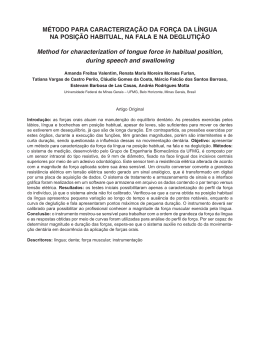COMPRIMENTO CLÍNICO E ANATÔMICO DO FRÊNULO DA LÍNGUA Clinical and anatomical lengths of the lingual frenulum Inajara Carla Oliveira, Renata Leite Lindoso, Alisson Dante Steil, Rafael Saviolo Moreira, Emerson Alexandre Sgrott, Fábio Aureliano Rafael, Vilma Bernardes, Tânia Terezinha Tozi Coelho Universidade do Vale do Itajaí – UNIVALI Itajaí – Santa Catarina/ Brasil Introdução: sabe-se que o frênulo da língua desempenha um papel importante na mobilidade da língua que é fundamental para as funções do sistema estomatognático. Estas funções podem estar comprometidas quando há alteração desta estrutura. As alterações do frênulo da língua são classificadas como: frênulo lingual curto, frênulo lingual com inserção anteriorizada e frênulo lingual curto com inserção anteriorizada. Porém, ainda há poucos estudos brasileiros referentes ao frênulo da língua e suas alterações. Objetivo: estudar a fixação do frênulo da língua em cadáveres. Métodos: trata-se de uma pesquisa quantitativa, realizada através do método de dissecação habitual topográfica. Foram avaliados os frênulos de língua de 40 cadáveres (de ambos os sexos) do Laboratório de Anatomia da Universidade do Vale do Itajaí – UNIVALI. As medições foram realizadas antes e após a dissecação da estrutura, seguido de fotografias para armazenamento. Como instrumentos de medida foram utilizados: um compasso de ponta seca; alfinetes e um paquímetro digital. A primeira medida consistiu na distância entre a origem do frênulo (OF) e sua inserção pré-dissecação (IPRD) e a segunda referiu-se à distância entre o final da inserção do frênulo pré-dissecação (IPRD) e o ápice da língua (AL). Para análise dos resultados foi realizado estudo estatístico para validar os resultados obtidos. Resultados: a média das medidas da origem do frênulo e sua inserção aumentou em 24,49%, partindo de 12,21mm na pré-dissecação para 15,20mm na pós-dissecação, e a média das medidas do final do frênulo ao ápice da língua diminuiu em 37,90%, de 6,49mm na pré-dissecação para 4,03mm na pós-dissecação.Conclusão: o resultado deste estudo demonstra que há uma variação importante nas dimensões das estruturas anatômicas do frênulo e sua inserção em relação às medidas comumente verificadas nos exames clínicos. Descritores: freio lingual; dissecação; caracterização CLINICAL AND ANATOMICAL LENGTHS OF THE LINGUAL FRENULUM Comprimento clínico e anatômico do frênulo da língua Inajara Carla Oliveira, Renata Leite Lindoso, Alisson Dante Steil, Rafael Saviolo Moreira, Emerson Alexandre Sgrott, Fábio Aureliano Rafael, Vilma Bernardes, Tânia Terezinha Tozi Coelho Universidade do Vale do Itajaí – UNIVALI Itajaí – Santa Catarina/ Brasil Introduction: it is known that the frenulum of the tongue plays an important role in the mobility of tongue that is fundamental to the functions of the stomatognathic system. These functions may be compromised when there is change that structure. Changes of frenulum of the tongue are classified as short lingual frenulum, lingual frenulum with anterior insertion and short lingual frenulum with anterior insertion. However, there are few Brazilian studies regarding the frenulum of the tongue and its amendments. Objective: to study the fixation of the frenulum of the tongue in cadavers. Methods: this is a quantitative research, conducted through the usual method of topographic dissection. We evaluated the frenulum tongue of 40 cadavers (both sexes) of the Laboratory of Anatomy, University of Vale do Itajai – UNIVALI. Measurements were taken before and after dissection the structure, followed by storage for photos. As measuring instruments were used: a compass needlepoint, pins and a digital caliper. The first measure was the distance between the origin of frenulum (OF) and its attachment pre-drying (IPRD) and the second referred to the distance between the end of setting the pre-drying frenulum (IPRD) and the apex of the tongue (AL). For data analysis was performed statistical analysis to validate the results. Results: the mean measurements of the origin of the frenulum and determination rose 24.49%, from 12.21 mm in the pre-drying to 15.20 mm in the post-dissection, and the average of the end of the frenulum to the apex of the tongue decreased by 37.90% from 6.49 mm in the pre-drying to 4.03 mm in the post-dissection. Conclusion: the result of this study demonstrates that there is an important variation in the dimensions of the anatomical structures of the frenulum and its fixation in relation to measures commonly found in clinical examinations. Keywords: lingual frenulum; dissection; characterization
Download
